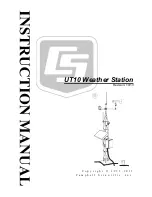
Version 2.0
©Copyright 2020, Ambient LLC. All Rights Reserved.
Page 57
Term
Definition
the wind is blowing.
Figure 47
10.
Specifications
10.1
Wireless Specifications
•
Line of sight wireless sensor array RF transmission (in open air): 330 feet, 100 feet under
most conditions
•
Line of sight WiFi RF transmission (in open air): 80 feet
•
Update Rate: Outdoor Sensor: 16 seconds, Indoor Sensor: 64 seconds
•
Sensor Array RF Frequency: 915 MHz
•
WiFi Console RF Frequency: 2.4 GHz
10.2
Measurement Specifications
The following table provides the specifications for the measured parameters.
Measurement
Range
Accuracy
Resolution
Indoor Temperature
14 to 140 °F
± 2 °F
0.1 °F
Outdoor Temperature
-40 to 149 °F (lithium
batteries)
-23 to 140 °F (alkaline
batteries)
± 2 °F
0.1 °F
Indoor Humidity
10 to 99%
± 5%
1 %
Outdoor Humidity
10 to 99%
± 5%
1 %
Barometric Pressure
8.85 to 32.50 inHg
± 0.08 inHg (within range of
27.13 to 32.50 inHg)
0.01 inHg
Light
0 to 200,000 Lux
± 15%
1 Lux
Rain
0 to 394 in.
± 5%
0.01 in
Wind Direction
0 - 360 º
± 10º
1º
Wind Speed
0 to 100 mph (operational)
± 2.2 mph or 10% (whichever
is greater)
1.4 mph
Figure 48
10.3
Power Consumption
•
Base station : 5V DC Adaptor (included), Power Consumption: 0.5 Watts (1.25 Watts during
WiFi configuration mode)
•
Base station: 3 x AAA batteries (not included)
•
Outdoor sensor array: 3xAA batteries (not included). The primary power source is the solar
panel. The batteries provide backup power when there is limited solar energy.
11.
Maintenance
1.
Clean the rain gauge once every 3 months. Rotate the funnel counter-clockwise and lift to
expose the rain gauge mechanism, and clean with a damp cloth. Remove any dirt, debris and
insects. If bug infestation is an issue, spray the array lightly with insecticide.







































